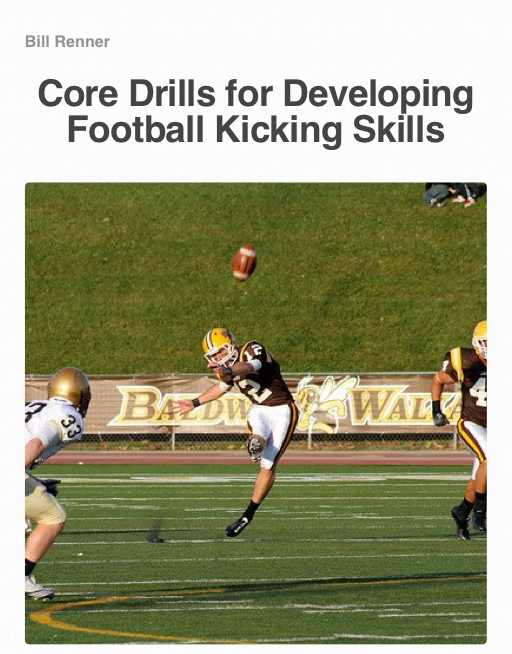Get Core Drills for Developing Kicking Skills for your iPad or Mac here.
Critical Points and Yardage by Coach Bill Renner
Second or third chances do not come often for kickers who fail to execute their skill. Offensive and defensive players can fumble, throw interceptions, miss blocks, get knocked down, miss tackles, drop passes, fall down and jump off-sides, yet, will only be considered to have “had a bad day”. Their abilities and position on the team will not be questioned.
This scrutiny and “perform or get cut” mentality from the coaches and fans demands a higher level of skill performance for kickers. Successfully combating this condition depends on the degree of technical knowledge the kicker possesses and how quickly adjustments can be made after poorly hit kicks.
The epitome of mastering this mental training is Tiger Woods. Rick Martino, director of instruction for the PGA of America, caught a comment Tiger made after shooting 40 on the front nine of his record setting 12 shot Masters victory in 1997.
“I remember him saying that day that when he finished the front side, he figured out his swing was too long.” Martino said. “No one had to tell him that, he knew it instinctively, and he managed to figure it out on the fly and make the adjustment. The rest of the week, you could see the difference.”
Just a glance at most professional kickers biography will produce a litany of teams they have performed for and been cut from. The ones that reduce this experience are the ones who have learned to correct mistakes immediately like Tiger Woods.
To start this learning process you must begin to believe two things:
1) the ball only goes where you cause it to go, and
2) a knowledge base of how to kick a football allows me to coach myself to correct my mistakes.
Without an understanding of the essential techniques that make the ball fly where and how you make it, fixing technique errors, whether “on the fly” or over a long term is impossible.
I have witnessed many talented kickers over the past 24 years as a player, coach, and operating punting and kicking camps. The ones that could perform under pressure and on command were the ones with the greatest understanding and control of the mental aspect of the skill.
How do you gain this knowledge?
1. Learn from experienced coaches and players.
You must have discerning questions when learning that allow you to focus on the essentials that make the ball travel where you want it to. For pkicking, as you learn the skill from others always filter the information through the following questions:
Kickers: “How will it make the ball go farther, higher or straighter?”
If the technique you are being told to do does not contribute to these results then it does not matter if you do it that way or not. PERIOD!
There are only certain essentials that must be executed to be successful at these skills and all the rest do not matter. In fact, those “essentials” are similar for both skills. There are not a lot of techniques to learn to kick well. But focusing your attention on the wrong ones will prevent your maximizing your ability. These questions will help you discern what those are.
2. Watch the ball fly and learn from what it does.
The flight of the ball is the best indicator of technique errors. An experienced instructor does not need to see you physically kick the football. He can watch the ball flight and tell you what you did at the collision to cause the football to fly the way it did.
With an understanding that the essential techniques are limited and what their cause and effect are correcting technique errors from ball flight is not a difficult process.
3. Develop a strong desire to master the skill.
Anyone can be taught to kick a football adequately. Few can be taught to do it on command. The desire to “BE THE BEST” is one factor that permits players to continue to advance to higher levels. The desire must translate to a strong work ethic.
“Woods loves to practice…If he wants to hit a shot that cuts 10 feet and only cuts six, he’s not happy with it,” (Peter) Kostis, widely regarded CBS analyst and teacher, said. “His tolerance is so small, it drives him to work even harder…”
Bill Renner has put together an interactive kicking manual that will help you develop a kicker right now. This illustrated manual includes 7 interactive, animated presentations that illustrate the coaching points and feedback to successfully kick the football. 12 movies illustrate the correct technique being descirbed in each chapter, and three movies give a telestrated, voice over of Coach Renner explaining the skill and the drills.
The training guide provides a recommended work out for kickers as well as a syllabus for all situations that a successful kicker must know and understand. This illustrated manual includes 7 interactive, animated presentations that illustrate the coaching points and feedback to successfully kick the football. 12 movies illustrate the correct technique being descirbed in each chapter, and three movies give a telestrated, voice over of Coach Renner explaining the skill and the drills.
The training guide provides a recommended work out for kickers as well as a syllabus for all situations that a successful kicker must know and understand.

